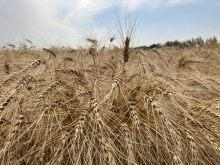Chicago Mercantile Exchange (CME) hog futures rallied on Thursday, breaking a four-day losing streak, after the U.S. House of Representatives approved funding to avoid furloughing meat plant inspectors, traders and analysts said.
The U.S. Senate passed the measure on Wednesday before the bill moved through the House Thursday morning.
Congressional approval fuelled more buying in the June through August contracts that would have been most impacted by the furloughs, said R.J. O’Brien hog futures trader Tom Cawthorne.
“Buying deferred contracts helped the April trading month despite challenges from lower cash prices and slow pork demand,” he said.
Read Also

U.S. grains: Corn, wheat ease after gains driven by Black Sea jitters
Chicago | Reuters – U.S. corn futures fell on Wednesday and wheat futures also dipped as fears eased about a…
Spot April hogs ended at 78.35 cents per pound, up 0.475 cent. Most-actively traded June closed up 1.05 cents to 89.55 cents (all figures US$).
This week, packers lowered cash hog bids amid plentiful supplies. Some producers are sending hogs to market in advance of possibly lower cash prices next week.
U.S. Department of Agriculture data Thursday morning showed the average hog price in the western Midwest region at $70.88 per hundredweight (cwt), down $1.25 from Wednesday.
From Monday to Thursday, packers slaughtered an estimated 1.703 million hogs, 10,000 more than a week ago and up 41,000 from a year earlier.
Live cattle gains
CME live cattle futures also drew support from Congressional backing for spending to keep meat plant inspectors on the job, analysts and traders said.
Before Congress approved inspector funding, traders sold the deferred live cattle futures for fear the furloughs would significantly hurt meat production, said Oak Investment Group president Joe Ocrant.
“On Thursday, some of that ‘risk discount’ was taken out and the deferred months will gain on the nearby trading months. The cattle report on Friday should speed up the process,” he said.
USDA will issue its monthly cattle-on-feed report on Friday at 2 p.m. CT. The agency will simultaneously release its monthly cold storage report to include February beef and pork inventories.
Analysts on average expect the cattle-on-feed data to show the number of animals placed in feedlots last month fell nine per cent from a year ago due to high feed costs.
A placement decline matching analysts’ forecast would be viewed as supportive for deferred live cattle futures.
Still, lower cash cattle prices so far this week prompted selling into rallies as slack beef demand wore down packer margins.
Cash cattle in Texas and Nebraska cattle traded at $124-$125/cwt, compared with $126-127, feedlot sources said.
There were no cash sales reported in Kansas. Bids were at $124-$125/cwt with sellers asking $126, a feedlot manager said.
Also, packers will require fewer cattle during the holiday-shortened work week next week. And, wholesale meat buyers are resisting purchasing fresh product at higher prices as frigid temperatures delay spring grilling.
USDA reported the price for wholesale choice beef Thursday morning at $192/cwt, $1.41 lower than on Wednesday; select cuts fell $1.13 to $191.90.
April live cattle settled 0.375 cent/lb. higher at 126.425 cents. June ended up 0.1 cent to 122 cents.
Feeder cattle futures ended firm with April futures keeping pace with CME’s feeder cattle index at 135.54 cents. Bearish spreads and deferred month live cattle market advances lifted remaining contracts.
Spot March feeder cattle ended up 0.05 cent/lb. to 135.15 cents. Most-actively traded April closed at 138.3 cents, 0.65 cents higher.
— Theopolis Waters writes for Reuters from Chicago.













